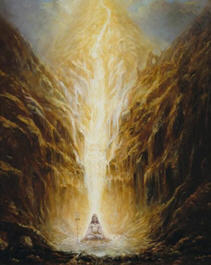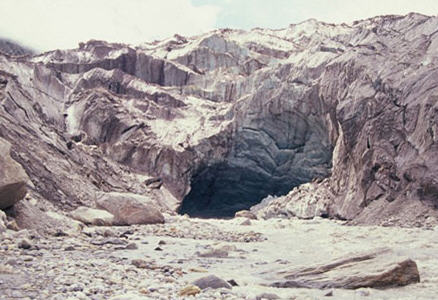In the Vamana Avatar Lila, Lord Vamana breaks open a hole in the covering of the universe. The Viraja which encircle the material world enters in the universe and the sacred Ganges because it touched the Lotus feet of the Lord Vamana.
The reason why King Bhagiratha desired that the Ganga descend to earth was to purify the remains of the 60,000 sons of his great grandfather, King Sagar. During Satya-yuga, King Sagar performed an ashvamedha yajna (a sacred horse ritual). This made the demigod Indra fearful that King Sagar may become more powerful than he. So Indra stole the horse and left it at the residence of Lord Kapila. King Sagar’s 60,000 sons went to look for the horse and thought Kapiladeva stole it when they found it at his ashrama. Kapiladeva had been in deep meditation and when he was disturbed, he burned the 60,000 sons by the power of his glance. Only Asamanjas survived and went back to tell King Sagar what happened. Then the king’s grandson, Asuman, returned to Kapiladeva and requested him to release the horse, which he did and explained that the king’s sons could be saved if, their remains could be bathed in the waters of the Ganga River. But in order to happen, Ganga Devi would have to descend from heaven to earth.

So King Bhagiratha pleased Ganga Devi to descend, but she explained that the force of her water descending from the heavenly region would destroy the earth. Therefore, King Bhagiratha pleased Lord Shiva to accept the powerful force of Mother Ganges the river on his head. Thus, the Ganges descended to earth, landing on the head of the powerful Lord Shiva, and then followed King Bhagiratha who cut a deep gorge in the earth with his chariot. This gorge went all the way to the Bay of Bengal at Ganga Sagar, the island where Lord Kapiladeva resided. There, the Ganges purified the remains of the 60,000 sons of King Sagar so they could return to the spiritual world. Now, because of King Bhagiratha, so many other pilgrims can also take advantage of the holy Ganga, and visiting Gangotri is considered a most auspicious event
. 
GAUMUKH:
This glacier is the actual source of the Ganges. Gaumukh means “cow’s face,” which the glacier is supposed to look like. However, because of the constant melting of the glacier, the shape is also always changing. It is a 100m (328 ft) high wall of gray snow. It is 30km (18.85 miles) long and two to four km wide. Years ago the glacier is said to have reached all the way down to Gangotri.
The best time to visit is between June to September. Before June and after the second week of October there is too much ice and snow on the path to be able to reach it. There is a rocky path, marked white on one side. It is 19km (some say 23km) northeast of Gangotri. Mount Shivling, 6,543m (21,470 ft), towers above the source of the Ganges. The water of the Bhagirathi gushes out from the glacier with great force and cuts a fantastic gorge out of the mountains. The climb is difficult at places.

Getting there :
It is 18 kilometers (though some now say 23) east from Gangotri to Gaumukh, the source of the Bhagirathi River. To reach Gaumukh you start climbing the stairway up the hill by the Ganga Devi temple that leads you to the path. As you start out along the path through the trees, it is not too strenuous. It does not go too high or too low. You will first see Kanakgiri Ashrama, which is two kilometers from Gangotri. The first refreshment stop is Bhojgaddi, which is four kilometers out. There are many bhoj trees in the area.
After 8 km you reach Chirbasa, at a height of 3606 meters which is basically a few tea shops and some tents with mattresses for staying overnight. From here the path leads to mountain desert. Just pass Chirbasa, where the cliff faces has deteriorated; there have been quite a number of accidents, so you have to be really careful at this point.
Most people stay the night in Bhojbasa, at a height of 3792 meters above sea level ,where there is no electricity. If you plan, to cross the glacier, you can get a guide here. From Bhojbasa it is a good 5km track to Gaumukh (2 hr). The path is marked by stones, but it is not clear-cut. Usually people take one day to reach Bhojbasa. The next day they go from Bhojbasa to Gaumukh and then return to Bhojbasa the same day. Then the next day they return to Gangotri. Most people spend a day or two in Gangotri in order to get used to the altitude before making this trek. Past Gaumukh is Tapovan
. 
Warning
There are many cases where people who did not stay in Gangotri to acclimatize and got very sick. There may also be a problem if you make the trip too quickly.
Practicalities
There is no place to stay in Gaumukh, but you can camp out there if you have proper equipment. There are tea stalls where you can get basic food. Five km from Gaumukh, at Bhojbasa, there is a Tourist Bungalow with four rooms, dorm beds, and two-person tents. It has a basic restaurant and hot water in a bucket for some rupee. There is also the Bhojbasa Ashram of Lal Baba, who provides free food and lodging for pilgrims. This is basically floor space. You should bring a warm sleeping bag, a torch (flashlight), and good shoes or boots.
Tapovan
Tapovan is a natural Sivalinga peak that rises 6,554 metres. It is called Tapovan because sadhus have performed penance there to realize the Absolute Truth. If you want to go there, you should have a guide, a good tent, Food, a warm sleeping bag, and warm winter clothes. To get there without a guide can be dangerous, as there can be huge holes in the glacier totally hidden by snow. But there are some people who have gone there without a guide, with no problem, except the fear of getting lost. Because of the decreased amount of oxygen in the air, one should also take it easy.
Tapovan is 4460 meters in elevation. It is a lovely meadow with natural blooming flowers. The side of the meadow has the stream called the Akash Ganga, which fades into Gaumukh. The famous Mount Sumeru is several more kilometers from Tapovan, which reaches a height of 6660 meters. On the other side of Tapovan are Nandanvan, Rakvan, and Sundarvan which can be seen. One can reach Kalandi through Nandanvan and from Kalandi one can reach Badrinath if taking the path through the mountains. Only well-equipped mountaineers usually go past Tapovan.
Tapovan is four hours past Gaumukh (5km). There is a sadhu who host visitors in his cave at Tapovan, but you should definitely bring your own food.
The Tapovan trek takes four days. Day1 Gangotri to Bhojbasa 14km Day 2 Bhojbasa to Tapovan 10km Day 3 Tapovan to Bhojbasa 10km Day 4 Bhojbasa to Gangotri 14km